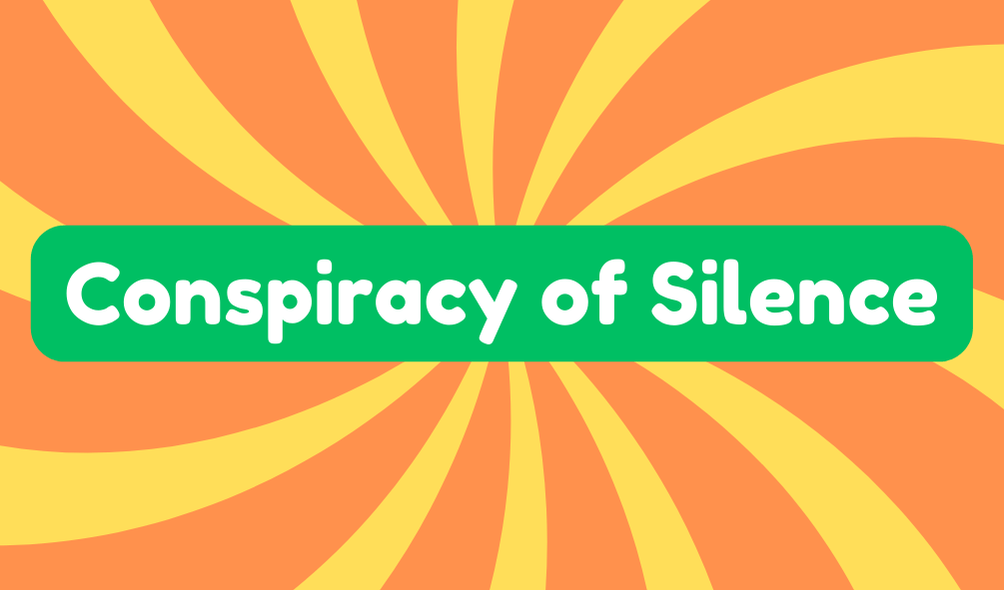A conspiracy of silence refers to the deliberate choice to ignore significant truths, often due to social pressure within groups. Its roots can be traced back to 1865, highlighting how loyalty sometimes outweighs the need for transparency. For instance, employees might stay quiet about workplace misconduct, fearing negative consequences. This silence fosters harmful environments where critical issues, such as systemic racism or healthcare negligence, remain unaddressed. By understanding this phenomenon, you can challenge these societal norms. Exploring the implications of silence helps promote a culture where open dialogue thrives and truth prevails. Curious about more examples?
Synonyms
There're several synonyms for the phrase "conspiracy of silence" that capture its essence. Each suggests a strong commitment to secrecy surrounding hidden truths and collective silence. Here are three key alternatives:
- Collusive Silence – This highlights a secret agreement to withhold information.
- Deliberate Silence – Emphasizes a conscious choice to ignore significant issues.
- Silencing Consensus – Signifies a collective decision to suppress knowledge and discussion.
When we examine these terms, we notice how they point to the uncomfortable reality of unsaid truths. They reveal how often society prioritizes protection over transparency, and they challenge you to think critically about what remains unspoken in your own circles. The need for open dialogue and accountability has never been more vital.
Example of Sentences
Understanding the concept of a conspiracy of silence can spark curiosity about how it manifests in real-life situations. You might notice it in several contexts that reveal social implications and ethical dilemmas:
- Employees whispering about unethical practices in the workplace, fearing repercussions.
- Patients feeling reluctant to share experiences of negligence in healthcare, concerned about their rights.
- Communities avoiding discussions about systemic racism to maintain peace.
These examples highlight how the silence surrounding critical issues can perpetuate harm, creating environments where truth is stifled. The need for open dialogue grows ever more critical, as ignoring these realities only serves to deepen the ethical dilemmas we face. By breaking the silence, you foster accountability and empower change in your community.
Origin
The phrase "conspiracy of silence" emerges from a collective behavior where groups choose to remain silent about uncomfortable truths or criminal activities. This idiom highlights how social psychology plays a significant role in maintaining these silences. Groups often prioritize loyalty over transparency, fearing social backlash if they speak out. Unlike cultural taboos, this silence usually pertains to specific political or social issues, implying a lack of honesty among members. The term has roots as far back as 1865, initially used to critique neglect. Your understanding of this phrase can empower you to question societal norms, recognizing when silence may protect harmful behaviors instead of fostering genuine accountability. Awareness is essential in breaking these cycles of collective behavior.
Collocations
Collocations related to "conspiracy of silence" often reflect the contexts in which this phrase is used. These phrases can help you understand how collective silence and secrecy agreements manifest in various situations. Here are some common collocations:
- Culture of secrecy: This implies a broader environment where silence is the norm, affecting communication.
- Silent agreement: Highlights a mutual understanding to keep issues under wraps, often tied to secrecy agreements.
- Veil of silence: Suggests a thick barrier preventing open discussion, reinforcing the detrimental effects of collective silence.
How to Use in Everyday Language
Using the term "conspiracy of silence" in everyday language can effectively convey the idea of collective secrecy. You might notice it in discussions about social dynamics, where groups might suppress crucial information for self-interest. Here's a simple table to illustrate its usage:
| Context | Example |
|---|---|
| Professional | "There's a conspiracy of silence around safety violations." |
| Community | "Residents fear discussing the crime rates due to a conspiracy of silence." |
| Corporate | "Is there a conspiracy of silence about management issues?" |
| Social Issues | "The community must break the conspiracy of silence about mental health." |
Recognizing the ethical implications behind such silences invites reflection, urging you to question why certain truths are hidden. This awareness can lead to more open dialogues.
Why Is It Still Relevant Today?
Confronting a conspiracy of silence remains essential today due to its pervasive impact across various sectors. It can dramatically affect social implications, hindering progress and accountability. For instance, in healthcare, professionals may remain silent about malpractice, which can lead to patient harm. Similarly, we often see contemporary examples in government, where inefficiencies go unaddressed due to fears of backlash. Communities are stifled when discussions about systemic issues, like racism and economic disparity, are silenced. This culture of silence not only protects self-interests but also prevents necessary innovations and solutions. By recognizing and challenging these conspiracies, you contribute to a more open society that values truth over loyalty, encouraging growth and informed discourse that can lead to real change.







